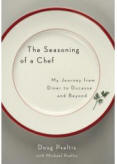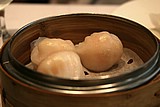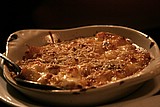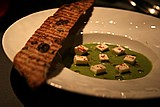Home |
Restaurants by City
|
Food Photography |
Archive | Philosophy |
![]()
Right now we are eating in Seattle, Washington.
|
Friday
2005
Permalink
|
I've been delaying writing about this book because I'm not sure how I feel about it. And frankly I'm a little gunshy given the reaction to the last time I wrote about a book. But let's dive in. Flame wars are always fun. The book is definitely readable. It only took me a couple of days to rip through it. Some of the literary maneuvers (like telling a story out of order for dramatic effect) seem tried on for size almost like the author has seen others do it and decided to see how it worked. But when a chef is writing a book (even with his brother who is said to have some skills in this area) this can be forgiven. I liked hearing the details of working in these kitchens. It's basically voyeuristic fun especially when you get to see the author treated to special privileges and perks by the Ducasse organization including visiting and working in his other restaurants. When I look at the individual parts of the book it adds up to the notion that I enjoyed reading the book. And in fact I did. And yet, there's also something unsatisfying about the book. It's kind of like a meal that has great technical execution but no soul. How do you separate the fact that your mouth is satisfied, but your heart isn't getting what it needs? That's kind of how the book was for me. Psaltis was telling his own life story. Even sharing intimate details about how he was feeling and tradeoffs he made, and yet the characters all felt two dimensional. Psaltis moves up the ranks of professional cooks in Manhattan methodically, and while he shares some of the tradeoffs he made, I never really felt them. In fact, I just really had no idea what kind of a guy he was. I walked away feeling that I'd gotten a somehow sanitized version of what happened. Not because he necessarily took out all the ugly details (though he did remove some) but the story just became one of a few repetitive notes: worked hard, learned stuff, sometimes encountered challenges, sometimes overcame challenges, sometimes got rewarded, moved on. In a way writing a book like this is almost impossible as nobody is ever going to be happy. If you aren't glowingly positive about everyone then people get insulted. (And sure enough Mario Batali and Jacques Pepin regret the blurbs they offered for the back of the book. My feedback to them - you get what you deserve for putting your name on something you didn't fully review. I would be more embarassed admitting that I put my name on something I'd never read than the fact that I endorsed a book that wasn't 100% glowing about Thomas Keller. Isn't the whole point of a chef's good name that they ensure their own personal stamp of quality is earned by every single thing they put in front of a customer? I wonder if you do the same cursory review of food you sell before you put your name on it?) And if you are glowingly positive then you've written a puff piece. It's clear that Psaltis is trying to strike what in his mind was probably a reasonable balance and set of tradeoffs that took into account being honest and not trashing people unreasonably. Mysteriously names of restaurants and chefs disappear or are changed whenever Psaltis has negative things to say about his experience. And in the case of his discussion about the French Laundry where he can't anonymize the tale, with every criticism of Keller and (mostly) his restaurant he loads us up with praise for the very same. I feel like I understand the goal, but unfortunately the book comes off as inauthentic. After reading it I enjoyed many of the details of the inner workings, but feel mostly unsatisfied. And after reading all the eGullet machinations I also end up wondering how much is true. Of course when you write your own story you're bound to put it through your own lens so some of that should be forgiven. In the end, this book kind of reminds me of the "reality" show The Restaurant with Rocco diSpirito. The book is entertaining. The backgrounds are from a world I like reading about - the world of professional cooking. But I never feel like I'm really seeing the truth. Things feel manufactured. One telling thing, with the Rocco show I kind of suspected that the food they were making wasn't something I would enjoy. And reports I've seen claim that I wasn't wrong. With Psaltis' book, I often wondered, do I want to eat this guy's food? I almost wanted to wait to write about this book until I've eaten at Psaltis' new restaurant - Country in Manhattan. Is it fair to look at the quality of a book based on the food prepared by its author? I say yes. Because ultimately if the food reflects the makeup of the book - entertaining but without soul, then my conclusion will be that the book in its worst light is a reflection of the author. But if the food is great, then I'll conclude that there's a great chef doing his best to be balanced and just misfiring in terms of coming off genuine. I don't know why this context should make a difference in my final estimation of the book, but for some reason it does. I guess its just hard to know how much credibility to give a chef/author when you've never eaten their food.
|
|
Our Sponsors
Free Car Listings Hot Tubs Stools Saunas Bar Stools - Calendar and Event Schedules - Food Events and Calendars - Wine Events and Calendars - Digital Photography Resources - Software for Advertisers - Jewish Gifts and Judaica - Howard Stern Podcast - ponytailed blogger Jonathan Schwartz

Browse tastingmenu
Home |
Restaurants by City X |
Food Photography |
Archive | Philosophy |
![]()
Free eBooks: All About Apples
| Autumn Omakase
More:
Discussion |
Cool Food T-Shirts |
Ingredients
| Markets |
Recipes
Search |
Blog FAQ |
Other
Blogs
Best of tastingmenu
|
City View
Entry: July 6, 2006 |
Blue Plate
Entry: June 19, 2006 |
L'Atelier de Joël Robuchon
Entry: July 18, 2006 |
Browse by City
Boston | Chicago | Houston | Las Vegas | Los Angeles | Maui | New York | Philadelphia | Portland | San Francisco | Seattle | Toronto | Utah | Vancouver | Washington D.C.
Bangkok | Beijing | Hong Kong | Seoul | Tokyo
Amsterdam | Berlin | Italy | London | Madrid | Paris | Vienna
Browse by Month
2006
2005
2004
2003
2002
2001
Comments, questions, or feedback:
info / at / tastingmenu / dot / com
All pages Copyright (c) 2001-2006 tastingmenu.com
Last modified 01/30/07.




